Our Security Blanket
They’re Soiling Our Security Blanket
Why Our Climate is Changing and What We Can Do About It
A Layman’s Perspective
Our security blanket is blue and happens to be made of air, but we cannot live without it. But now some people are messing with it to the point that they just may ruin it entirely. Sometimes it’s good to stop and look at a problem from a distance, in this case maybe from about 100,000 miles away. What we see is the most beautiful blue planet because of the oceans, but also because of the “thin blue line” surrounding it as first noted by our astronauts. That is my – and your – security blanket. Without it the days would be about 250º F and the nights would be about – 250º F as they are on our moon.
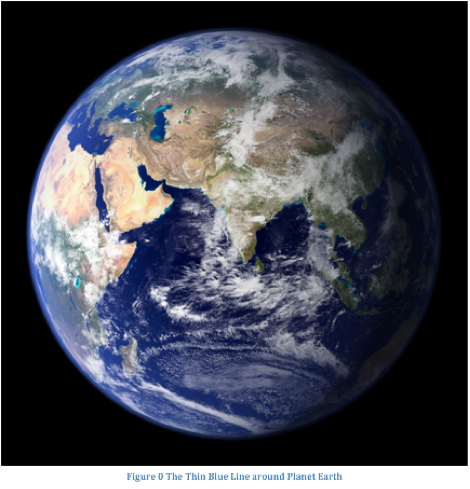
The Thin Blue Line
In a way it is truly magical that this thin veil that turns a deep blue when the sun shines upon it, is really all that sustains us. [See also the interactive global map here.] For it gives us oxygen to breathe, carbon dioxide for the plants to breathe, and clouds to produce rain and snow – our water to drink, and breezes to cool our brows. It is also amazing that at various times and places this seemingly benign and placid cocoon can turn viciously angry, and visit upon us storms of biblical proportions.
So shouldn’t we be doing everything in our power to nurture and care for this wonderful gift of life? Does it really make sense for us to use our atmosphere as a dumping ground? Let’s take a look at where we have been, where we are, and where we’re going.
In the desert southwestern United States, where I live, there are many ancient remains of cliff dwellings that were once occupied by the Anasazi.
Archeologists have found middens below the cliffs where the people dumped their trash. In today’s terms we would say they threw their garbage onto the front lawn. In ancient Rome rubbish was simply thrown into the streets, especially in the poorer neighborhoods. Over time, new construction was built on top of the old dumps. So it is clear that we humans have a long tradition of trashing our environment. In more recent times, after industrialization, abuses were often the result of corporations using rivers for their toxic wastes and the air for smoke emissions. The latter caused acid rain, smog and the raining down of particulates that wreaked damage to people’s lungs.
To our credit the U.S. Congress passed effective laws and regulations that greatly reduced pollution of our rivers and the air we breathe. Thus we know that we can, if we have the will, correct abuses of great magnitude and even to restore damaged environments.
The Greenhouse
So what’s all this about greenhouse gases?
First of all, how does a greenhouse work, and how does that translate to our atmosphere, and to the weather? When sunlight enters a greenhouse it warms up everything inside. The warm air is trapped and can’t blow away. A warm body gives off infrared radiation, but this too is trapped by the glass to some extent. So even when it’s cold outside, the interior of a greenhouse can be much warmer.
But how can this possibly apply to a gas like carbon dioxide, CO2, in our atmosphere? It was a Swedish chemical physicist, Svante Arrhenius, who in 1896 proposed that the carbon dioxide in our atmosphere was responsible for the fact that the earth – floating in space of almost absolute zero temperature – could remain warm. He later wrote:
“To a certain extent the temperature of the earth's surface, as we shall presently see, is conditioned by the properties of the atmosphere surrounding it, and particularly by the permeability of the latter for the rays of heat." And further…….”any doubling of the percentage of carbon dioxide in the air [e.g. through industrialization- Ed.] would raise the temperature of the earth's surface by 4° C [7.2° F]; and if the carbon dioxide were increased fourfold, the temperature would rise by 8° C [14° F]”.
Ref: Wikipedia/Svante Arrhenius
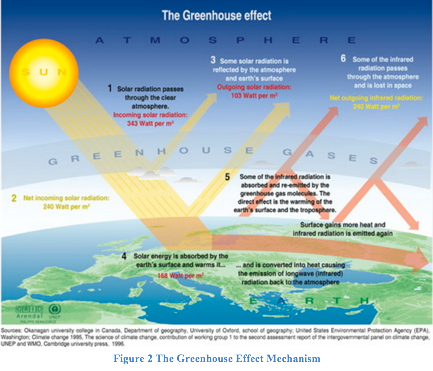
The reasoning was as shown in Figure 2. It is the ability of some molecules to radiate back down some of the earth’s up-radiation of infrared (heat) rays that makes CO2 and others into greenhouse gases.
[Ref: Our Energy.com]
So for many millions of years the earth had this nice, comfy blanket to keep it warm as it floated serenely through frigid space. All sorts of animals from dinosaurs to little fish lived out their lives protected by this benign covering. And then Man* came upon the earth and discovered fire, which could cook his food and power his engines. Man found petroleum and coal to fuel his fires and they all produced carbon dioxide. All through the ancient ages humanity was relatively small in numbers, and our presence fit well with the balance of nature. The green plants breathed in his carbon dioxide and gave him food to eat, and all was well upon the face of the earth. But Man was aware of God’s edict to, “Be fruitful, and multiply, and replenish the earth…” (Holy Bible, Genesis 1.28). And this first part Man did – in spades! But he forgot about the second part of God’s command – to replenish. Here in Figure 3 is a diagram in which the red line represents human population, in billions [‘BP’ means ‘Before Present’].
[Ref: University of Michigan].
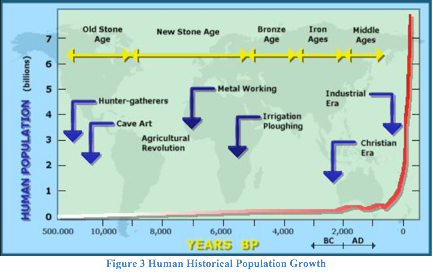
So it was only around the year 500 AD that Man – humankind – really got cranking with the fruitful and multiply thing. The shape of this curve is called an exponential increase, since in every year the population builds upon itself so that it rises faster in every succeeding year. It is not surprising, then, that global concentrations of carbon dioxide have been increasing apace. We see this clearly in Figure 4 below. These measurements were taken from three sources: (1) from about the year 1,000 to recent times, from air trapped in ice cores taken in Antarctica, (2) more recently from the Hawaiian mountain Mauna Loa, and (3) from air just above the surface of the ocean. The data from the last two were in very close agreement, and the two curves – from ice and from air – joined the prehistoric one almost perfectly.
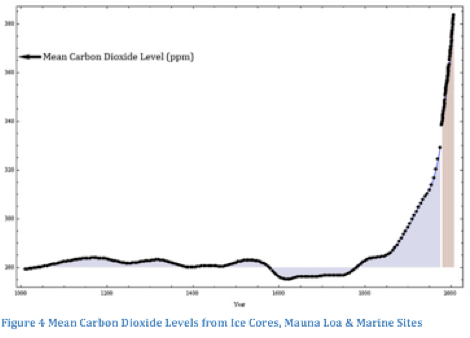
As a result it should be no surprise that the earth overall is warming, and that human activities are most likely responsible.
When I got out of college in 1949 I went to work for the Scripps Institution of Oceanography in La Jolla, California as a sea-going chemist. The Head of the Institute was Roger Revelle, revered by his colleagues for his knowledge and sagacity. He sailed with us at times. Revelle picked up where Arrhenius left off, conducting research on atmospheric CO2 and showing correlations with global warming.
Revelle’s research on climate change was a major factor in his selection for the 1990 National Medal of Science. The research program that resulted in the later-stage Mauna Loa and sea-level data was a direct result of Revelle’s initiative. He hired a young scientist named Charles Keeling, who actually made the measurements, and it is that part of the curve which known as the Keeling Curve. There’s an almost perfect correlation with the population growth curve in Figure 3 above.
And these CO2 levels, in turn, produce increases in temperatures as shown in the curves in Figure 5. These are record changes. They are higher than any historical data, e.g. the Eemian interglacial maximum that occurred some 125,000 years ago.
Global Climate Change
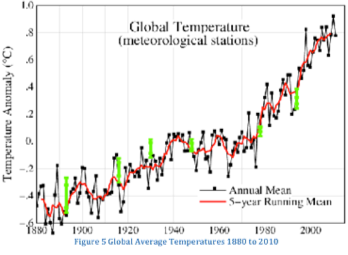
Let me take just one example that shows the consequences of warming. Nothing can be more dramatic and on such a huge scale as the melting of glaciers. In Glacier National Park more than 150 glaciers have already disappeared, and now scientists estimate that all the glaciers will be gone by the year 2020. Here is what is happening to one of the greatest, Grinnell Glacier (Figure 6) [- Ref: Grinnell Glacier Melting].
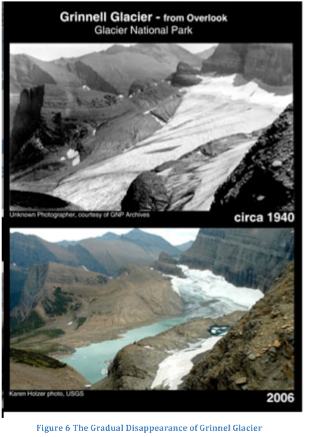
Sources of Carbon Dioxide
I think most people by now recognize that human activity produces CO2 . But it’s worth looking at the major sources, and then at what individuals and families produce.
Figure 7 below shows us that: (1) global production has been climbing inexorably since 1890, (2) it’s increasing faster since 2000, and major economic changes such as the dissolution of the Soviet Union, global oil shocks, and recessions produce just blips on the curve.
Increases at this rate, if continued, are totally unsustainable. The absolute amounts of CO2 being produced are measured in thousands of millions of metric tons (gigatonnes - Gt) or billions of tonnes. If we take the sum of all energy-related sources only for 2012 and convert it into volume of CO2 being dumped into our beautiful blue atmosphere, we get about – I hope you’re sitting down for this – 5,000,000,000,000,000 (or 5.0 X 1015) gallons of the gas in a single year.
Of course the plants of the earth, trees, grasslands, farms and gardens, as well as the oceans, consume a large amount of this, but not nearly enough, as we see from Figure 7. This global production of CO2 is such a huge number that it’s really impossible to get our minds around it. So let’s look at CO2 production on a personal or family scale. According to the U.S. Environmental Protection Agency (EPA) the average passenger car in the year 2013 emitted 0.93 pounds of CO2 per mile, which translates to 61 gallons of CO2 per mile (Figure 8), or to 5.1 tonnes per year, and to approximately 760,000 gallons of CO2 gas in a year [Ref: EPA]. And this doesn’t include the other major truly toxic pollutants, i.e. carbon monoxide and oxides of nitrogen (NOx) that are not greenhouse gases.
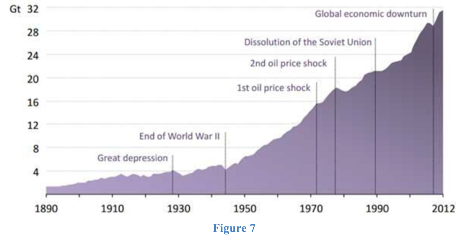
If this path continues, the IEA estimates we’ll see between 3.6°C (38.5 ℉) and 5.3°C (41.5 ℉) degrees of global warming over pre-industrial levels, most of it within the next hundred years. That’s in line with projections in Nature magazine of 5°C (41 ℉) degrees of warming, all of which would be a temperature rise unheard of in human history.
Climate Change
Recent extraordinarily violent climatic events include:
•Hurricanes Katrina, Sandy, Harvey and Irma
•Record high temperatures, drought and fires in California and Australia
•Record floods in New England, the Carolinas and Texas
•Historic snowstorms in New England
•Drought in the Midwest and especially California
•Typhoons in the Philippines, Burma & Bangladesh.
•….. and many more violent disasters.
The loss in human lives is truly incalculable, and the loss in treasure, likewise.
Dr. James Hansen is former Director of the NASA Goddard Institute of Space Studies and currently Professor at Columbia University, and is perhaps the world’s foremost expert on global climate change. Anyone who has looked at a weather report on television and has watched the swirling of highs and lows and clouds and sunshine, has experienced the complexity. But today, with massive computers and weather stations all over the earth, scientists can not only forecast our weather for the current week, but also make good predictions of long-range weather patterns. And Hansen has been an eloquent and largely correct prognosticator of what we now are experiencing. Many others have confirmed his predictions. He says that Planet Earth is in big trouble if we allow global warming to exceed 1 degree Celsius.
Frances Beinecke, President of the Natural Resources Defense Council (NRDC) stated after hurricane Sandy:
“The human toll is hard to grasp but all too real: more than 100 people have paid with their lives. Tens of thousands more have lost everything; for them life will never be the same. Dozens of devastated communities are torn apart, feeling suddenly and terribly vulnerable to the next storm on the horizon.
These are the terrible costs of our increasingly extreme weather. Of the ten costliest hurricanes to hit the United States since 1900, eight have occurred in the past eight years -- and that was before Sandy.“
The Bottom Line on the Thin Blue Line
Scientists have been predicting global warming due to carbon dioxide emissions into our atmosphere ever since Arrhenius in 1896. More recently weather scientists have predicted that warming leads to more extreme weather events. These have been occurring with greater ferocity and frequency right on schedule, as predicted, and with horrendous consequences in terms of loss of life and livelihood and treasure.
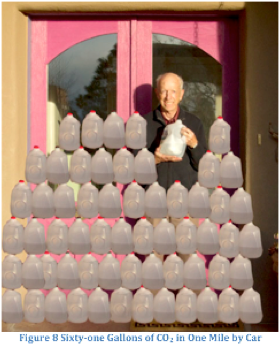
How much more do we have to suffer before we get our act together? If we do not, our children and their children for generations to come may live in a much more weather-violent world as a result of our greed and stupidity.
The solutions are there facing us. Kyoto and Doha and other international meetings have given us clear guides on what needs urgently to be done, but so far the United States, one of the biggest polluters, has been unable to sign a single treaty dealing with the amelioration of global climate change [The US and China did sign an “agreement” in November, 2014 to significantly lower greenhouse gas emissions].
There are hopeful signs all around us, primarily in the realm of reductions in use and the development of alternative ways to produce energy. Take a single example: Is there enough sunlight to generate electricity from solar panels alone? The map in Figure 9 (Ref: Solar Power from PV’s) shows what the potential is across the U.S. If we take just the state of New Mexico we would get enough electricity to power the entire country by covering a mere three percent of the area of the state with photovoltaic (PV) panels!
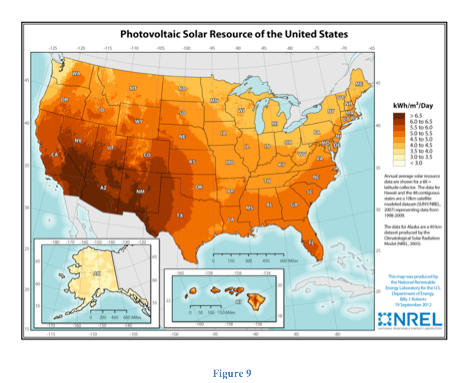
Finally, on a personal note, you may fairly ask if I have been an honest broker in this business. To which I reply that I do what I can. I have one of the largest private solar arrays – both heat and electricity - in this little town in Northern New Mexico; I have a water and space heater that uses natural gas and that is over 95% efficient. These all run beautifully, and provide a good payback on the capital investment. I go around turning off lights and closing curtains in winter; I recycle everything the town will take; I compost our garbage (yes it produces some methane, but most of the carbon goes into garden soil); we’ve just bought a much more energy-efficient refrigerator; and I just bought a Toyota Prius that gets at least 55 miles per gallon of gasoline.
Now, returning to God’s commandment to replenish the earth, I trust that believers would want to be good stewards of this incredible, sacred gift, our thin blue security blanket.
Let’s all help save Planet Earth.
It’s our only source of chocolate
-- and its atmosphere is truly our security blanket!
--------------------------
NB: All of the above on global warming and climate change is available in a small book entitled GASP! They’re destroying our security blanket. For copies please contact the author at www.bob@bobfitch.com. For more information please check out the “Home” page of this website.
-----------------------------------
Comments
Dec. 28, 2015
We traveled quite a lot when we lived back east and loved to visit the capitals of Europe, for a week or ten days, to emerge [sic] ourselves in the local culture. London is my favorite city and if our count is accurate we've been there 79 times and know the city maybe as well as most Brits.
Our problem with travel, to far away places in the current day and age, is the awareness of the staggering carbon footprint left by air travel. From Reno to JFK, one passenger creates 3.89 metric tons of CO2 and from Reno to London it's 5.35 metric tons of CO2, per passenger.
Here we are driving a Prius squeezing every last mile we can out of a gallon of gas. We keep the temp down in the winter and up in the summer to use as little natural gas and electric power as possible all in the name of doing our part to curtail greenhouse gas emissions. The thought of offsetting our home based efforts, with a trip to London, gives us pause. It's the old saying " a feather doesn't weigh anything but a feather bed does " that keeps us fairly close to home doing our part to limit our contribution to CO2 emissions.
- Barry Downs, Reno Nevada
Jan. 29, 2015
“The five Republicans who voted in favor of the Democratic amendment that made the strongest connection between human activity and climate change deserve credit for doing so. But the flip side is that 49 out of the 54 [i.e. 91% - rmf] Republicans in the Senate voted against an amendment that merely states mainstream scientific theory, as vetted by countless researchers, studies and assessments over the course of more than a quarter of a century. And 39 [72%] refused to agree to a statement that linked human activity and climate change in any way. Moreover, it is not clear that any of the Republicans, or indeed many of the Democrats, are prepared to actually do anything significant about it.”
- Nature magazine Vol. 517, No. 7536
“Many experts also criticized China’s target of reaching a peak in its carbon emissions by 2030 as little more than business as usual.
“Many other major emitters — including Australia, India and Russia, as well as petrostates like Saudi Arabia and Venezuela, whose economies depend on continued markets for fossil fuels — do not appear likely to offer up similar targets anytime soon.”
Also: The Republican-led Congress is sure to do whatever it can to frustrate even this small progress. [rmf]
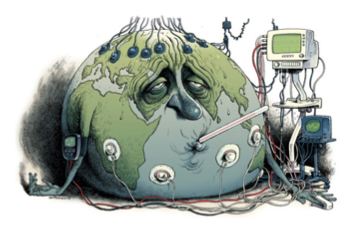
*And this:
NYTimes,Oct. 24, 2014
“EU Heads of State and Government have agreed the headline targets and the architecture for the EU framework on climate and energy for 2030. The agreed targets include a cut in greenhouse gas emissions by at least 40% by 2030 compared to 1990 levels, an EU-wide binding target for renewable energy of at least 27% and an indicative energy efficiency target of at least 27%.”
Nevertheless, it’s still hard to believe that in the US to this day this topic is “controversial”: This from the New York Times on October 25, 2014:
“While politicians are increasingly willing to include environmental messages in their campaigns, many at the national level still steer clear of the politically charged topic of climate change.”
It can only be “politically charged” because our “representative” government is the best that money can buy.
Readers’ COMMENTS
Thank you for your most cogent blog on Climate Change. It is dead (hopefully not) on, and one that comes home to roost constantly.
When we redid our kitchen 4 years ago, we selected a German company that produced the cabinetry from 80+% recycled materials.
We recycle all that the Town will take like yourselves and we have a lot of solar gain in the house so that our thermometer remains at 62 degrees.
There is much more we can do and it will be important to see if Congress takes any action this term. Obama has not really taken the lead on this but now that he no longer will stand for election perhaps he will?
The Kyoto Protocol has never been ratified by the US and Canada just opted out. What an embarrassment to all world-wide.
-Robert Parker, Architect and Artist
--------------------
“Texas in 2011 experienced the worst wild fire season on record. Taken together, the fires blackened an area larger than Connecticut.”
- National Geographic Magazine, Sept. 2012, p. 49.
I stated in January 2013 that maybe we would soon have an international accord to limit carbon emissions to avert the disastrous results of climate change. As of 2018 we have such an accord with some 195 nations signing on. Now our disastrous president has chosen to withdraw from this treaty:
https://en.wikipedia.org/wiki/Paris_Agreement
- rmf
----------------
Today’s NY Times (1/14/13) reports that a draft of a report by “a Federal Advisory Committee” is available for public comment before publication. It’s a BIG report, and gets things right with regard to human impacts on our climate. Go to: http://green.blogs.nytimes.com/2013/01/14/an-alarm-in-the-offing-on-climate-change/?hp. Maybe the United States will finally take a global leadership position on this most important issue!
-rmf
----------------
I have one very strong opinion related to your discussion of global warming. I too recycle etc as you and Robert Parker discussed, and I will continue to do so, and I wish everyone did, but I believe those small steps are nothing but a mouse fart in a hurricane. Industrial polluters, which definitely include our cities, towns, and especially (in NM), our government labs and military institutions, overwhelm the minuscule efforts of individuals and households, even in our small non-industrialized town and state.
-Dave Schultz, (former NASA) Engineer,Taos, NM
I agree that of course we have to address the HUGE outputs of industrial factories, and many of their products. That was why I gave the data in Figure 7. But don’t underestimate the power of large numbers of people. In the U.S. alone there are almost 312,000,000 of us, and if each of us could drive just one less mile (and maybe ride a bike to work? - as I did for years), we could put some 19 BILLION gallons less of carbon dioxide into our thin blue atmosphere!
-rmf
-----------------
For some reason, this topic seems to be treated as a side note by the general public. ........
Our built environment also needs to be modified. The existing housing stock needs to have non-heat absorbing roofing materials installed, more energy efficient appliances and mechanical/plumbing devices installed. Roads, driveways, sidewalks need to be replaced with water permeable, non-heat absorbing materials to reduce the need for cooling in the urban centers.
The car industry really needs to get it's act together and revise the engines that they are providing in new cars with the newest technologies, all of which have been around for a while now. It would help if the government could provide more incentives for folks to buy the cleaner cars......
We have gotten to the point where we are consuming the last resources available and it is time to start focusing on the renewable and recycled resources that are available instead. We have built our urban centers to trap heat, we have used so much raw material in the building of these urban centers, and are so tied to everyone having their own vehicle or having the food, goods and services that we want trucked to our location, that we have lost track of a simple life. We need to build with materials that are locally manufactured, eat food that is locally grown, dress appropriately for the weather, and start relying on bicycles, foot, or public transportation. We need to force our local governments to provide better public transport, and change our ways of thinking and consuming. These are big changes, granted, but bigger changes will be forced upon us all at once if we don't start easing into it now.
- Consuela Osborne, architect and biologist
--------------------
We think your article on Climate Change is spot on! As you illuminate, the evidence is pretty overwhelming that human activities, around the world, produce global warming which leads to climate change. To deny the phenomenon is like claiming that if something looks like a duck, walks like a duck and quacks like a duck, it's not a duck!
Too few people realize that each individual, paying close attention to his or her own carbon footprint, can make a difference. Driving a hybrid vehicle, or better yet, an electric vehicle and using natural gas to heat and cook, is a meaningful step forward. A map of the US with thousands of airplanes, crisscrossing the country, spewing out not only carbon dioxide but other toxic chemicals, makes one ask how many people aboard those planes really need to be there? The answer is, not many, and just one less plane leaves one less carbon footprint. As the saying goes "a feather doesn't weigh anything but a featherbed does".
It remains to be seen if the human race will take climate change seriously and change its behavior before it's too late? We are not optimistic!
Again, your article was great! Many thanks and we are passing it along to our email contacts.
- Barry Downs, Financial Consultant & Nancy Downs
------------------
On an encouraging note, President Obama in his second inaugural address had this to say:
“We, the people, still believe that our obligations as Americans are not just to ourselves, but to all posterity. We will respond to the threat of climate change, knowing that the failure to do so would betray our children and future generations. Some may still deny the overwhelming judgment of science, but none can avoid the devastating impact of raging fires, and crippling drought, and more powerful storms. The path towards sustainable energy sources will be long and sometimes difficult. But America cannot resist this transition; we must lead it. We cannot cede to other nations the technology that will power new jobs and new industries – we must claim its promise. That’s how we will maintain our economic vitality and our national treasure – our forests and waterways; our croplands and snowcapped peaks. That is how we will preserve our planet, commanded to our care by God [There’s that ‘replenish’ bit! - ed]. That’s what will lend meaning to the creed our fathers once declared.”
He must have read this blog! - rmf. Jan. 2013
